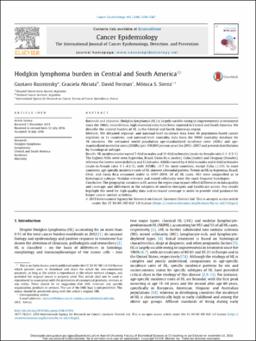Hodgkin lymphoma burden in Central and South America.

View/
Date
2016-09Author
Kusminsky, Gustavo.
Abriata, Graciela.
Forman, David.
Sierra, Monica S
Metadata
Show full item recordAbstract
RATIONALE AND OBJECTIVE:
Hodgkin lymphoma (HL) is largely curable owing to improvements in treatment since the 1960s; nevertheless, high mortality rates have been reported in Central and South America. We describe the current burden of HL in the Central and South American region.
METHODS:
We obtained regional- and national-level incidence data from 48 population-based cancer registries in 13 countries, and national-level mortality data from the WHO mortality database for 18 countries. We estimated world population age-standardized incidence rates (ASRs) and age-standardized mortality rates (ASMRs) per 100,000 person-years for 2003-2007 and present distributions by histological subtype.
RESULTS:
HL incidence rates varied 7-fold in males and 11-fold in females (male-to-female ratio 1:1-2.5:1). The highest ASRs were seen Argentina, Brazil, Costa Rica (males), Cuba (males) and Uruguay (females), whereas the lowest were in Bolivia and El Salvador. ASMRs varied by 4-fold in males and 6-fold in females (male-to-female ratio 1:1-4.3:1), with ASMRs <0.7 for most countries, except Cuba (≥1.0). In most countries, age-specific incidence rates of HL showed a bimodal pattern. Trends in HL in Argentina, Brazil, Chile, and Costa Rica remained stable in 1997-2008. Of all HL cases, 48% were unspecified as to histological subtype. Nodular sclerosis and mixed cellularity were the most frequent histologies.
CONCLUSION:
The geographic variation in HL across the region may in part reflect differences in data quality and coverage, and differences in the adoption of modern therapies and healthcare access. Our results highlight the need for high-quality data and increased coverage in order to provide vital guidance for future cancer control activities.

